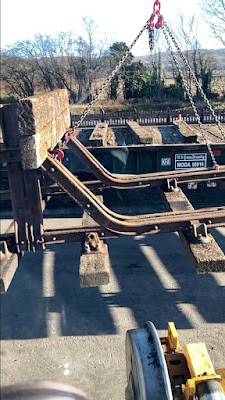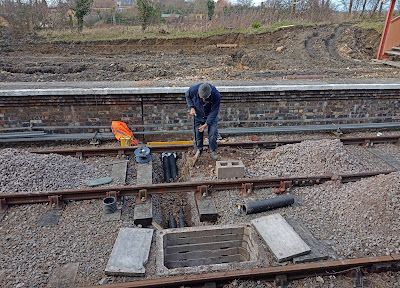Last Thursday on conduits.
We are close to completing the cross platform conduits. One item necessary for that was a wacker plate, which the railway has. It's currently at Toddington, so first thing on Thursday we dropped in to retrieve it.
We had already received a volunteer announcement not to park near the loco shed, as a delivery of concrete sleepers was expected.
And there it is - the lorry had already arrived, and was waiting to be unloaded. What the Warflat was carrying is already stacked up against the sheds behind it.
We located the wacker plate, and soon Neal was using it to compact the infill of the platform side trench across the tracks.
We also started to back fill the P2 side trench connecting with the centre drain.
The drain pipes in it had been pushed through as far as they will go into the blockwork under the platform.
Once the foundations of the building are in, we can dig a trench on the P2 side to bring the conduits to their final destinations within the building to be.
The storm had brought down a dozen Heras fencing panels, placed there a year ago.
Meanwhile, Neal set about completing the final part of the conduits under the track. We have penetrated the platform wall at foundation level, but as mentioned above the other side is not yet excavated pending the casting of the floor slab.
Here we have the conduits from P1 with the services. The hole in the wall was covered with a paving slab and the rest filled in again.
At the end of the day all traces of trenches under the tracks had gone. A small quantity of surplus ballast remains (displaced by the conduits) but this may come in useful when we Robel around the sleepers affected by the digging.
Earlier in the day we had the visit from the building inspector, and all was fine. We can now arrange a date for pouring the concrete in the trenches. The concrete will be pumped in across the tracks with a pump, with the mixer parked on the station forecourt.
Friday at Broadway.
Cold and bright - a great day. It was half a day of logistics for us. We went down to Winchcombe to fetch a Transit, but only with some difficulty. The Toddington to Winchcombe Road is blocked for 2 weeks, so we went via the B4077 and the Black Barn crossroads to Greet. Or tried to. Big accident, road also closed. (Three car accident, we learned later)
Back to Toddington, then down a tiny lane through Didbrook. This was also being used by 30 ton tipper lorries and a bus.
At Winchcombe the site looked very busy. There were two concrete lorries, the yellow one pouring concrete into the floor slab of the new S&T building, and the blue one waiting to follow on with a second load.
The central slab had just been poured, and the DPM laid for the second on the right.
But we were after some trestles and scaffolding boards for Broadway. They will be used to construct a temporary support for the concrete pump, which will move the concrete from the mixer lorry on the forecourt to the P2 foundations across the tracks.
After unloading the supplies, we lifted the rather heavy wacker plate back on the truck. We dropped it off at Toddington, the took the Transit back to its base.
Lunch was in the signal box as usual. It's got comfy chairs and is out of the wind.
While we were away Neal dug out the trench again, and made a sump hole for the standing water.
The ash covered platform 2 surface is now covered in a 2 inch thick blanket of clay. So that we don't distribute this every time we take the dumper out on the tarmac, we spent most of the afternoon peeling this clay layer off and carting it away in the dumper.
This picture shows big lumps of that two inch thick layer of clay.
While we took the Transit back Neal built this trestle road between the platforms.
Its purpose is to support the pipe from the concrete pump that will transport fresh concrete from the forecourt to the P2 foundations. That pipe, over its length with concrete, will be pretty heavy, so a double layer of boards was used.
The actual day for the concrete still has to be determined, but it's soon.
Neal and John jumped into the trench to clear out clay and ash that had fallen in.
Soon there was a further pile of great grey clay slabs on the ash platform surface.
PWay on Saturday
Cutting and shutting at Manor Lane.

Good progress is being made towards the target of the foot crossing, still out of sight to the right. Bert Ferrule is staring at the sky - another interesting flyover perhaps?
Standing on said foot crossing, you can see that the gang has passed the signal post and is getting ever nearer. If you look carefully as well, you can make out several dipped joints on the right, which is why we are 'cutting and shutting' this stretch of s/h rail.
Monday at Broadway.
Three of us again, getting the trenches ready for the concrete pour.
First thing though we put the slabs back in the platform. Our cross track conduits are in, and you will find it difficult to know where they are (under the piece of wood in the foreground...).
A very neat job.
In a week's time we have a concrete lorry and a concrete pump coming. This means that the forecourt will be blocked for half a day, so we went to advise the B&B that uses our forecourt.
On the way back we snapped this picture from their drive.
I think we can pat ourselves on the back that we got a fair representation of the 1904 station, except that we only built two chimneys, instead of the three that there were. They are also thinner.
The footbridge is a dead ringer!
Neal had foreseen the need for shuttering in a part of the trenches, so had 4 large sheets of plywood ready. These he cut into strips.
It's the side along the platform that keeps collapsing. This is because that has no original clay, but was back filled with loose material after we rebuilt the platform.
Then we built a little footbridge into the centre, and laid out the plywood strips.
The northern part of the trench has standing water in it, while the southern part is nice and dry.
The hole on the left of Neal is for a block of concrete to support the chimney here. Neal is cutting the sides to shape for more plywood strips.
It took most of the day, but the front and northern part of the trenches are now ready.
We have a short bit still to do round the back.
The last thing then will be to get the laser level out, and hammer lengths of bar into the ground to indicate the correct height of the concrete pour. We've go one more working day planned to do that, so all is on schedule and we are just about ready.
Towards the end of Monday we took another shot of the site from the footbridge, showing the trestle bridge for the concrete pump, and the completed trenches with shuttering.
We also went over almost all of the platform again, picking off the thick layers of clay left by the dumper while carrying away the spoil. You can now walk along the platform again (on ash) without getting great clods of clay on your boots. There will be alot of walking around soon when we lay the concrete blocks.
Wednesday with the Usketeers.
A full complement, including Jules. He's still there, but can't come anymore, but we may look forward to occasional visits.
A peace offering was made:
8 salted caramel tea cakes, and a big roll of chocolate biscuits. Jules knows how to ingratiate himself, but will they last until his next visit? We don't think so....
Our first job today was something to which we had been looking forward, and with much preparation.
It was bolting the trespass sign, donated by a kind blog reader, to the rail cut by PWay Peter for us.
So what's it look like? Like this ! The sky shows you that the weather was quite stormy today, although dry. A private helicopter flew overhead very noisily, and at and angle of 45 degrees to the direction of flight due to the strong wind up there.
Here's the post being installed. If we don't do this, the gate can wrench itself off its hinges. We've done all the digging with the Telehandler for now (or maybe not, some new thoughts are forming...) so this post should not get knocked over now.
Just to be sure we will paint the top of white next week. Once the concrete has gone off, we can also install the hook and eye.
We thought we'd treat ourselves to a group photograph round our little bit of GWR heritage. From L to R:
Dave, Jules, John, Paul. As 5 people were too many for a selfie, Yours Truly is behind the camera here. Use your imagination...
Later in the day we caught John pulling out another stump. Pretty hard work, very courageous of him, but the work keeps John healthy.
Dave grabbed the wheelbarrow and started bringing in topsoil from the pile on the other side of the fence.
With this topsoil we can level the site of the rough drops of spoil we got earlier, and make it ready for seeding.
We also fitted a more modern sign what we were asked to attach to the gate, so we now have two that mean +/- the same thing, but go about it in different ways. After all, in future the public will be milling around (?) in this area.
The more modern sign was designed to look like a BR enamel from the 1950s, which is Winchcombe station's chosen period.
Here's a nice summary shot we did at the end of our day's work. Fence completed, new signs, and topsoil barrowed in.
Next is grass seeding, but we have run out of seeds so will need to buy some more in.
For your delectation we also had a quick look over on the S&T building site. There was no work today, but a lorry came with deliveries.
These blocks here are for the interior, we ascertained.
The floor has been cast in concrete, and no doubt is waiting to go off for the regulatory period involved.
Now you can see the size of the building quite well.
There will be an awning in the area on the right.
Blues and reds have also been delivered. Those are the GWR brick colours, but we like the reds used at Broadway more.
These here (not so visible in the picture) have a purplish tint to them, while those used at Broadway have more old fashioned looking orange, and we paid extra to have some sort of 'dirt' effect on them, which gives the building a nice period look.


















































































